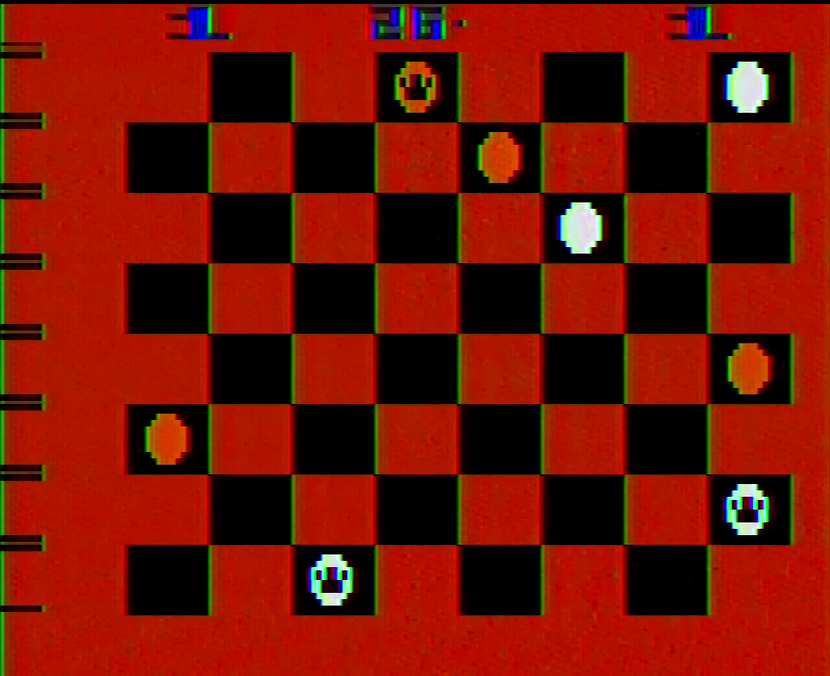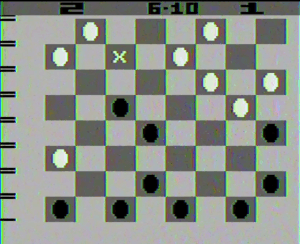
At the same time Alan Miller was working on Activision’s Checkers cartridge in late 1979, at Atari, Carol Shaw had started work on her own translation of the board game, with both designers oblivious to each others’ efforts. While not as visually striking as Miller’s game, Video Checkers has more options and a stronger computer opponent, making this a better challenge for those who are pretty decent players already.
Having already gone over the tale of computerized and console checkers titles with the entry about Activision’s game, this one will be wholly focused on Atari’s. Fortunately, we have a great deal of information about how Video Checkers came together thanks to two sources: an interview historian Benj Edwards conducted with Shaw back in 2011, where she discussed her development process for Video Checkers at some length; as well as her 2017 donation of papers and materials to the Strong Museum of Play in 2017.

The idea for Video Checkers, Shaw told Edwards, came from Larry Wagner and Bob Whitehead’s Video Chess. She said she was inspired to create a checkers program after seeing that nigh-miraculous feat of programming on the VCS, considering it an interesting project to work on. As to its actual creation, Carol Shaw’s papers at the Strong Museum include her surviving design notes for Video Checkers. The earliest relevant papers include drawn mock-ups of the game display and are dated Feb. 12, 1980, with color choices and the numerical notation for where a piece is starting and where it’s going. Other design sheets include her drawings of what the pieces and cursor would look like and a map of the move-tree-lookup that her game uses. According to her interview with Benj Edwards, she had been consulting with Arthur Samuel, designer of an early checkers program for the IBM 700 computer in the mid-1950s, just as Alan Miller had been, and while she had experience with move trees from 3-D Tic-Tac-Toe, Samuel had come up with the concept of alpha-beta pruning, where the computer stops following a move “branch” once the outcome along it becomes too disadvantageous. Shaw remarked that Video Checkers used a more sophisticated algorithm than what she’d previously designed for 3-D Tic-Tac-Toe, with her own implementation of alpha-beta pruning to speed up the computer’s “thinking” process; in a 1983 interview Shaw remarked that she felt since the 1950s, improvements to checkers programs had largely come from processor speeds rather than algorithmic changes.

As part of her late-stage development process, Shaw’s papers reveal that she would pit her program against other checkers programs. In March and April she wrote down notes of putting it up against Mattel’s Intellivision Checkers cartridge, seemingly tweaking her computer opponent based on the notes until her program could beat theirs at difficulty level 4 and higher. Later in April she added two of the Checker Challenger standalone games and the Video Brain version to her competitive roster, wherein she wrote in a report dated April 25th the only time the Video Checkers computer lost at level 5 was against the Video Brain game on difficulty C. In all other instances, her game would either force a draw or win, despite a glitch in the decision tree that would force her game to make random moves – which she fixed before the game was finalized. She also reported adding code to ensure her program could win in a situation where one king is facing two at level 6 or higher, and hoped to generalize this to apply for more situations before finalizing her code. Her noted likely final code revision came on May 13th.
With a 4-kilobyte cartridge, Carol Shaw put together a pretty feature-complete version of checkers. Aside from the two-player mode, her game features 9 levels of computer AI, with the first four being “amateur grade” opposition and 5 through 9 being professional level. Accordingly, the time her computer takes to consider its moves runs between about 1 second on the lowest difficulty up to 15 minutes on the highest. On levels 1 through 3, the game doesn’t make any attempt to consider the positions of any pieces, merely the number of them on the board, with extra weight towards kings; at levels 4 and above the computer is taking into consideration where pieces are, how to protect the back row to prevent kings and protecting the valuable corner spaces. And that’s just for normal checkers. Her cartridge also features the “giveaway” ruleset where the goal is to end the game with all your pieces either removed or blocked from moving, and these also have varying degrees of computer skill to play against. Shaw’s cart features the ability to set up the board how you want using the left difficulty switch, as seen in Atari’s previous strategy games, while the right difficulty switch will swap sides. This includes in the middle of a game, so you can effectively force the computer to play itself. Finally, Shaw programmed in the standard checkers notation for the board to allow people to set up specific scenarios seen in checkers strategy books. The end result of her work is an opponent that provides a solid challenge at basically any skill level; the lowest difficulties are enough to make a beginner sweat, but the higher ones will put a solid player through their paces. While not as visually stylish as the Activision game that had debuted a month earlier, Atari’s own cart is pretty easy to recommend over it based on the opponent and the other setup options.

A memo dated June 24 has Shaw pitting Video Checkers against Miller’s own VCS version, as someone in the office had managed to get a hold of his game’s ROM file and brought it in. She notes here that his game is smaller and has fewer features. Putting up Miller’s game against hers at his level 3 difficulty and her level 5, Shaw’s game ended up winning. Dropping her game difficulty down to level 4 allowed Miller’s game to be victorious, while pitting Miller’s level 1 computer against hers at level 2 resulted in a tie game. Despite having a stronger game, she did remark that she liked the visual design of his checkers pieces and that he’d managed to maintain vertical sync during the computer “thinking” processes, where the screen display vanishes or displays random colors.
This would be Shaw’s final solo VCS game while at Atari. Aside from writing a version of 3-D Tic-Tac-Toe and a calculator program for the Atari 8-bit computer line, the rest of her time at Atari saw her effectively assisting other developers; she worked on the graphics for Ed Logg’s digital conversion of Othello, and started work on a home version of Super Breakout before leaving the company once the display and some game variant proof-of-concepts had been completed; both were eventually published in 1981 with Nick Turner finishing the latter title. Shaw not only left Atari but also the video game industry entirely for a while following what she called a “mini-bust period” in 1980 to work at Tandem Computing Systems. She’d return to games in 1982 after being headhunted by her de facto checkers-development rival Alan Miller to work at Activision.
The sole review of the game I’ve turned up, in the March 1981 edition of Video Action, is somewhat measured. Reviewer Howard Kaye indicated that Atari had done well a standard game well, if in a mundane manner; he added that he could really only recommend it for someone dedicated to the board game, as it was much cheaper to just buy a checkers set if you’re not so committed. Video Checkers does show up on Atari Corporation’s 1986-1990 internal sales data files. According to those, the company sold a little over 33,000 copies between 1986 and 1988, making it the most successful of Atari’s strategy games at that time. It sold more than double what Backgammon did in that same time period, about 9,000 more copies than 3D Tic-Tac-Toe, and far, far removed from the whole 106 new copies of Video Chess sold in those years. So in that regard Video Checkers seemed to have a healthier time on the market longer than its peers, possibly owing to how relatively approachable checkers is compared to those other titles.
And interestingly, this is basically the end of the line for checkers games on home consoles for a good while. While you can find checkers and draughts games for computers going forward, and eventually on handheld platforms, as far as I’m aware no other home game console put forth their own version beyond this in the 1980s, save for Mike White producing and selling copies of Bally’s unreleased Checkers cartridge for the Professional Arcade console in 1986. This isn’t terribly surprising in some ways. While checkers is a game of strategy, it doesn’t have the same prestige as chess programs do, and in any event home consoles were proving even then to be an awkward fit for classic strategic games in general. A home computer version would have access to more game program space and more memory to provide a stronger challenge, and in the future handheld games can provide a greater amount of portability for places where you can’t bring a cheap checkers set, leaving home consoles to just be an awkward way to play the game. But if you’re into computer checkers, the VCS has two perfectly sound takes on it, and Carol Shaw’s game is the way to go for stronger players even if it doesn’t look quite as nice as the Activision one.
Sources:
The Carol Shaw papers, Strong Museum of Play
Carol Shaw: Atari’s First Female Video Game Developer, Benj Edwards, Vintage Computing and Games, Oct. 12, 2011
Atari Corp. 2600 Sales figures, 1986-1990
New Cartridges Are Here!!!, Arcadian, Dec. 20 1985
Interview with Three Game Designers, David Ahl and Betsy Staples, Creative Computing Video & Arcade Games, Fall 1983
Atari Adds Four Games, Announces Major Promotion, Leisure Time Electronics, Fall 1980
Prima Facie, Howard Kaye, Video Action, March 1981
Game release date sources:
Video Checkers (September 1980): Rochester Democrat and Chronicle, November 16 1980; Lansing State Journal, September 24 1980; Daily Herald Suburban Chicago, October 22 1980; Shreveport Journal, November 19 1980
Checkers (Intellivision, February 1980): Modesto Bee, December 10 1979; Santa Ana Orange Counter Register, March 27 1980;Blue Sky Rangers game list; Rochester Post-Bulletin, Feb. 28 1980, Detroit Free Press, Feb. 29, 1980, Tacoma News Tribune, Feb. 11 1980
Checkers (Bally Arcade, December 1985): Arcadian, December 20 1985
